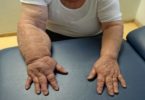What's in this article?
Polycystic ovary syndrome (say “pah-lee-SIS-tik OH-vuh-ree SIN-drohm”) is a problem in which a woman’s hormones are out of balance. It can cause problems with your periods and make it difficult to get pregnant. Polycystic ovary syndrome also may cause unwanted changes in the way you look. If it isn’t treated, over time it can lead to serious health problems, such as diabetes and heart disease.
Most women with Polycystic ovary syndrome grow many small cysts on their ovaries. That is why it is called polycystic ovary syndrome. The cysts are not harmful but lead to hormone imbalances.
Early diagnosis and treatment can help control the symptoms and prevent long-term problems.
Hormones are chemical messengers that trigger many different processes, including growth and energy production. Often, the job of one hormone is to signal the release of another hormone.
The exact cause of polycystic ovary syndrome is unknown. Early diagnosis and treatment along with weight loss may reduce the risk of long-term complications, such as type 2 diabetes and heart disease.
Polycystic Ovarian Syndrome Facts
- Polycystic ovarian syndrome (PCOS) is an illness characterized by irregular or no periods, acne, obesity, and excess hair growth.
- Women with PCOS are at a higher risk for obesity, diabetes, high blood pressure, and heart disease.
- PCOS’s main signs and symptoms are related to menstrual disturbances and elevated levels of male hormones (androgens).
- With proper treatment, risks can be minimized. Ideal treatment is directed to each of the manifestations of PCOS.
What causes Polycystic Ovary Syndrome?
The cause of Polycystic Ovary Syndrome is unknown. But most experts think that several factors, including genetics, could play a role. Women with Polycystic Ovary Syndrome are more likely to have a mother or sister with Polycystic Ovary Syndrome.
A main underlying problem with Polycystic Ovary Syndrome is a hormonal imbalance. In women with Polycystic Ovary Syndrome, the ovaries make more androgens than normal. Androgens are male hormones that females also make. High levels of these hormones affect the development and release of eggs during ovulation.
Researchers also think insulin may be linked to Polycystic Ovary Syndrome. Insulin is a hormone that controls the change of sugar, starches, and other food into energy for the body to use or store. Many women with Polycystic Ovary Syndrome have too much insulin in their bodies because they have problems using it. Excess insulin appears to increase production of androgen. High androgen levels can lead to:
- Acne
- Excessive hair growth
- Weight gain
- Problems with ovulation
Symptoms of Polycystic Ovary Syndrome
Symptoms of Polycystic Ovary Syndrome typically start soon after a woman begins to menstruate. The type and severity of symptoms varies from person to person. The most common characteristic of Polycystic Ovary Syndrome is irregular menstrual periods.
Because Polycystic Ovary Syndrome is marked by a decrease in female sex hormones, this condition may cause women to develop certain male characteristics, such as:
- excess hair on the face, chest, stomach, thumbs, or toes
- decrease in breast size
- deeper voice
- thin hair
Other symptoms include:
- acne
- weight gain
- pelvic pain
- anxiety or depression
- infertility
While not symptoms of the disease, many women with PCOS have other concurrent health problems, such as diabetes, hypertension, and high cholesterol. These are linked to the weight gain typical in PCOS patients.
Treatment for Polycystic Ovary Syndrome
There’s no cure for Polycystic Ovary Syndrome, but the symptoms can be treated. Speak to your GP if you think you may have the condition.
If you have Polycystic Ovary Syndrome and you’re overweight, losing weight and eating a healthy, balanced diet can make some symptoms better.
Medications are also available to treat symptoms such as excessive hair growth, irregular periods and fertility problems.
If fertility medications are ineffective, a simple surgical procedure called laparoscopic ovarian drilling (LOD) may be recommended. This involves using heat or a laser to destroy the tissue in the ovaries that’s producing androgens, such as testosterone.
With treatment, most women with Polycystic Ovary Syndrome are able to get pregnant.





